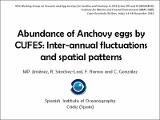Por favor, use este identificador para citar o enlazar a este item:
http://hdl.handle.net/10261/325384COMPARTIR / EXPORTAR:
 SHARE
BASE SHARE
BASE
|
|
| Visualizar otros formatos: MARC | Dublin Core | RDF | ORE | MODS | METS | DIDL | DATACITE | |

| Título: | Abundance of Anchovy eggs by CUFES: Inter-annual fluctuations and spatial patterns. |
Autor: | Jiménez, María Paz; Sánchez-Leal, Ricardo Félix; Ramos, Fernando; González, C. | Palabras clave: | Centro Oceanográfico de Cádiz Anchovy Pesquerías CUFES Spawning area Gulf of Cádiz Eggs |
Fecha de publicación: | 14-nov-2016 | Citación: | ICES Working Group on Acoustic and Egg Surveys for Sardine and Anchovy in ICES Areas VIII and IX (WGACEEG).. (14/11/2016 - 18/11/2016. Capo Granitola (Sicilian, Italy)). 2016. . En: , . | Resumen: | Data on the abundance of Anchovy eggs in the Gulf of Cadiz as collected by CUFES are explored in the present work in relation to their spatial pattern and inter-annual fluctuations. These data were gathered in 12 summer surveys, both acoustic (ECOCADIZ series) and DEPM (BOCADEVA series) ones, since 2004 to date (no survey in 2012). A total of 1499 CUFES stations were sampled, which distributed from the strait of Gibraltar, in Spain, to Cape San Vicente, in Portugal (in 2010 to Cape Sta. Maria only). The sampling scheme consisted in a grid of 21 parallel transects, normal to the shoreline and inter-spaced 8 nm, with the samples being collected every 3 nm at a c.a. 600 l/min flow with a 335 μm mesh size net and at a sampling depth of 5 m from the surface. A continuous record of SST and SSS at 5 m (termosalinometer) was coupled to the CUFES sampling. The surveys were carried out in June, July or August depending on the year. Oceanographic variables such as temperature, salinity and chlorophyll, and even the bottom topography of the shelf as well, they all showed significantly different in two regions: to the East and West of the Cape S. Mª. The density of Anchovy eggs presents a high variability between stations showing a very patched distribution. The stations with most eggs are located to the East of Cape Sta. Mª. Egg abundance also showed a very high between-year variability, ranging from 2955 eggs in 2005 to 41941 eggs collected in 2014. Regarding the spatial pattern of egg distribution, the 84.9% of the total egg density (all the surveys pooled) was collected in the area east of the Cape Sta. Mª (37.4 % in 2016), and the 89.8 % of total egg density in stations bellow 100 m depth (47.9 % in 2016). What happened in 2016? The mean temperature registered in 2016 in the Western stratum (22.0ºC) was practically the same that the mean temperature registered from 2004 to 2015 in the Eastern stratum (21.7ºC). The analysis of the centers of gravity of the eggs densities vs longitude and depth show significant trends, but not for latitude, which indicate a displacement towards the West in 2016. However, no trends were found in the centers of gravity of the acoustic energy (NASC) as a proxy of adults. Is then the westward displacement of the spawning in 2016 caused by an advective transport (currents and/or winds) or by other causes? What will be the further effect on recruitment? It would be good to obtain a statistical model in order to explain how the different variables affect the abundance of eggs, including other variables like the wind, tide... The presence of deep canyons crossing the shelf in the East of Cape Sta. Mª indicates that distance to the coast would be a better variable than depth. | URI: | http://hdl.handle.net/10261/325384 |
| Aparece en las colecciones: | (IEO) Comunicaciones congresos |
Ficheros en este ítem:
| Fichero | Descripción | Tamaño | Formato | |
|---|---|---|---|---|
| CUFES Anchovy eggs abundance.pdf | 3,32 MB | Adobe PDF |  Visualizar/Abrir |
CORE Recommender
NOTA: Los ítems de Digital.CSIC están protegidos por copyright, con todos los derechos reservados, a menos que se indique lo contrario.
